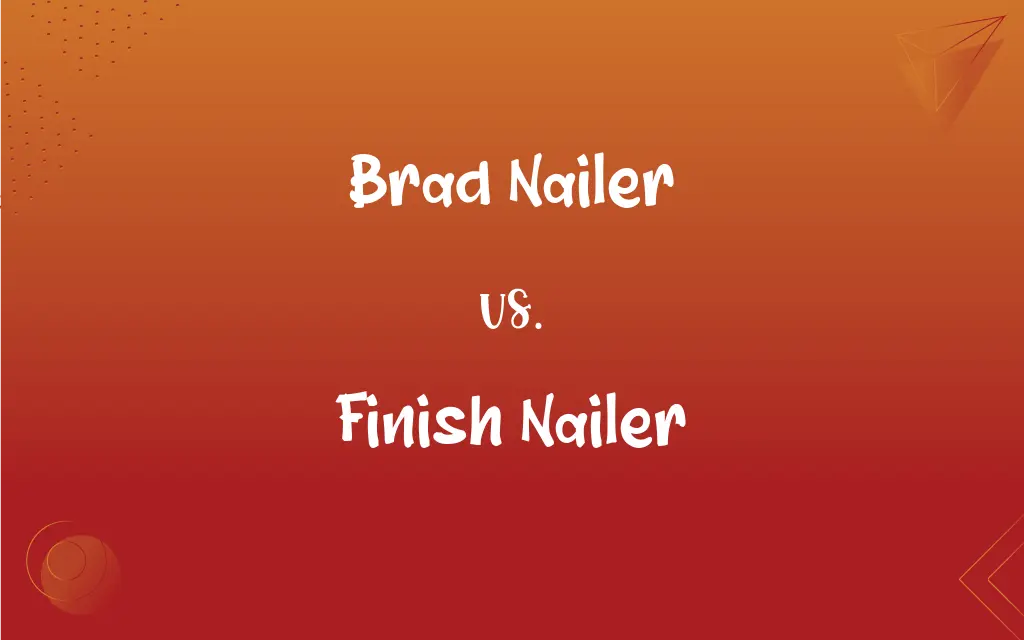Brad Nailer vs. Finish Nailer: What's the Difference?
Edited by Aimie Carlson || By Janet White || Published on January 17, 2024
A brad nailer uses smaller 18-gauge nails for delicate trim work without splitting wood, while a finish nailer uses larger 15 or 16-gauge nails for stronger hold in larger trim.

Key Differences
Brad nailers are designed for precision work, utilizing 18-gauge brads that are thinner and less likely to split delicate trim or molding. Finish nailers, in comparison, use thicker 15 or 16-gauge nails, providing a stronger hold suitable for heavier trim and molding. Both tools are essential in carpentry for attaching trim, but they serve different purposes based on the size and delicacy of the materials.
The brad nailer is ideal for intricate trim work, cabinetry, and small moldings where a fine finish is required. In contrast, the finish nailer is better suited for larger, more substantial pieces of trim and carpentry work where the nail's holding power is paramount. Although both tools are used for finishing work, the scale and required holding strength of the project determine which is more appropriate.
Brad nailers leave a smaller hole that often doesn't require filling or can be easily concealed with minimal wood putty. Finish nailers, on the other hand, leave a larger nail hole that may need more filling and finishing work. This difference affects the post-application work, impacting the overall finish and appearance of the project.
In terms of application, brad nailers are more suitable for lighter, thinner materials where the risk of splitting or damaging the wood is a concern. Finish nailers are used for thicker, more robust materials where a stronger bond is needed. Each tool provides a specific type of hold and finish, making them uniquely valuable for different aspects of woodworking.
From a technical standpoint, brad nailers are often lighter and more maneuverable, making them easier to handle for precision work. Finish nailers are generally heavier and more robust, offering the necessary power for driving larger nails into tougher materials. The physical characteristics of each tool align with their intended applications in fine or more substantial carpentry tasks.
ADVERTISEMENT
Comparison Chart
Nail Gauge
18-gauge (thinner nails)
15 or 16-gauge (thicker nails)
Ideal Usage
Delicate trim, small moldings
Heavier trim, larger molding
Nail Hole Size
Smaller, less visible
Larger, more noticeable
Material Suitability
Lighter, thinner materials
Thicker, robust materials
Tool Size and Weight
Lighter, more maneuverable
Heavier, powerful
ADVERTISEMENT
Brad Nailer and Finish Nailer Definitions
Brad Nailer
A precision nailing tool, perfect for small moldings and trim work.
The brad nailer was perfect for the intricate crown molding in the living room.
Finish Nailer
Ideal for larger moldings and substantial woodworking projects.
The finish nailer was necessary for the thicker baseboards in the hallway.
Brad Nailer
A lightweight nailing gun designed for minimal wood damage.
For this fragile frame, a brad nailer is the best choice to avoid cracks.
Finish Nailer
A tool used in carpentry for larger nail holes requiring more filling.
After using the finish nailer, I spent some time filling and sanding the nail holes.
Brad Nailer
An essential tool for fine woodworking and cabinetry.
The cabinetry work required the precision of a brad nailer for a flawless finish.
Finish Nailer
Suitable for projects where nail visibility is less of a concern.
The robust frames were a job for the finish nailer, as nail visibility was not an issue.
Brad Nailer
A tool used for driving 18-gauge nails, ideal for delicate woodworking.
I used the brad nailer to attach the thin trim without splitting it.
Finish Nailer
A powerful tool for driving 15 or 16-gauge nails in heavy trim work.
I used a finish nailer to ensure the door trim was securely attached.
Brad Nailer
A carpentry tool that leaves barely visible nail holes.
Using a brad nailer meant I had less wood putty work to do afterward.
Finish Nailer
A nailing tool that provides a strong hold in robust materials.
For the stair railings, the strength of a finish nailer was indispensable.
FAQs
What is a finish nailer?
A finish nailer is a tool used for driving thicker 15 or 16-gauge nails, suitable for heavier trim work.
What projects are best for a finish nailer?
Finish nailers are best for heavier and larger trim, such as door casings and baseboards.
What size nails do brad nailers use?
Brad nailers use 18-gauge nails, which are thinner and less likely to split wood.
What is a brad nailer?
A brad nailer is a tool used for driving thin 18-gauge nails, ideal for delicate trim and moldings.
Can a finish nailer replace a brad nailer?
While a finish nailer can be used for some tasks of a brad nailer, it's not ideal for very delicate work.
Are finish nailers suitable for delicate wood?
Finish nailers can be used on delicate wood but with caution due to their larger nail size.
Are brad nailers good for heavy molding?
Brad nailers are not the best choice for heavy molding due to their smaller nail size.
Can finish nailers be used for furniture making?
Yes, finish nailers can be used in furniture making, especially for larger pieces.
Do brad nailers leave visible holes?
Brad nailers leave smaller, less visible holes compared to finish nailers.
What is the main advantage of a finish nailer?
The main advantage of a finish nailer is its ability to provide a strong hold in thicker materials.
What are brad nailers commonly used for?
Brad nailers are used for delicate trim work, small moldings, and cabinetry.
Can brad nailers use finish nails?
No, brad nailers are designed specifically for thinner, 18-gauge brad nails.
Do brad nailers require wood putty for holes?
Brad nail holes are small and may require minimal or no wood putty.
What safety precautions are needed when using a finish nailer?
Safety goggles and awareness of the tool's power are essential when using a finish nailer.
What is the nail gauge for finish nailers?
Finish nailers typically use 15 or 16-gauge nails for a stronger hold.
Is a brad nailer easier to maneuver?
Yes, brad nailers are generally lighter and more maneuverable than finish nailers.
Can finish nailers handle outdoor projects?
Yes, finish nailers can be used for outdoor projects, especially where strong hold is needed.
Are brad nails visible after painting?
Brad nails are less visible after painting due to their small size.
Can brad nailers be used for hardwood?
Yes, brad nailers can be used on hardwood, but care must be taken to avoid splitting.
Are finish nailers more expensive than brad nailers?
Finish nailers can be more expensive than brad nailers, depending on the brand and features.
About Author
Written by
Janet WhiteJanet White has been an esteemed writer and blogger for Difference Wiki. Holding a Master's degree in Science and Medical Journalism from the prestigious Boston University, she has consistently demonstrated her expertise and passion for her field. When she's not immersed in her work, Janet relishes her time exercising, delving into a good book, and cherishing moments with friends and family.
Edited by
Aimie CarlsonAimie Carlson, holding a master's degree in English literature, is a fervent English language enthusiast. She lends her writing talents to Difference Wiki, a prominent website that specializes in comparisons, offering readers insightful analyses that both captivate and inform.































































